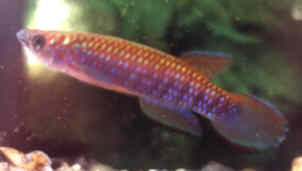Epiplatys fasciolatus tototaensis Romand 1978

E.fasciolatus tototaensis. Photo: Roger Gladwell
| Meaning of Name |
After Totota, the area of collection. |
| First Description |
Romand R. 1978. Description d'un nouveau Cyprinodontidae du Liberia, Epiplatys fasciolatus fasciolatus n. ssp.. Cybium 3 (4): p 43-50, figures. |
| Size |
7 cm |
| Meristics |
|
| Karyotype |
n = 19, A = 38 (Scheel 1990) |
| Sub-Genus |
Epiplatys |
| Group |
fasciolatus |
| Synonyms |
|
Populations
|
Gold - This form circulated in the southeast of England around 1986 / 87. The person naming this form is unknown but the fish exhibited a paler body colour with a preference to gold rather than blue scales on the body. The black outer marginal banding was less pronounced in this form. |
| Type Locality |
3 km south of Totota on the road from Monrovia to Totota, southern Liberia. The biotope was a small river 2-3 metres in width. |
| Distribution |
Southern Liberia. Ranges from the lower Saint Paul River to the lower Cestos River. http://homepage.uibk.ac.at/homepage/c102/c102mr/epiplaty/tototaen.htm |
| Habitat |
Rainforest brooks & small rivers. On the collection trip LIBOF 21 pH varies in collection locations from 6·7 to 4·3. These from locations 3 & 4. |
| Distinguishing Characteristics | Many fasciolatus populations can be identified by two narrow red bands in the outer part of the anal fin. In tototaensis these bars merge. |
| Colour/Pattern Variability | Scheel in ROTOW 1 commented on seperating the 1965 import (then thought to be E.fasciolatus fasciolatus) from E.fascialatus fasciolatus by the anal fin. E.fascialatus fasciolatus has 2 thin red lines towards the outer edge. E.fascialatus tototaensis has a single, more broader red band. |
| History |
Live fish were imported into Germany from Totota in 1965. |
| Breeding Notes |
An
easy fish to breed. I have kept them on a number of occaisions & found them
no problem to reproduce, laying eggs in top & bottom mops which I took out
& water incubated in seperate containers. Paul Webber in BKA Newsletter No. 262/263, June/July 1987 stated that fry would appear in the parents tank which grew rapidly, sexing out in 10 weeks. He remarked that this was twice as fast as rearing away from the breeding tank. |
| Diameter of Egg | 1·5 mm. |
| Remarks |
Males appear to be non aggresssive to females or offspring. |